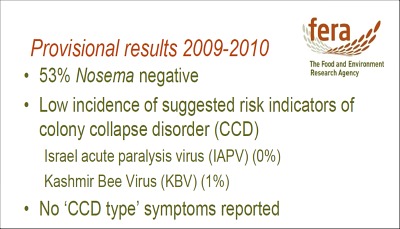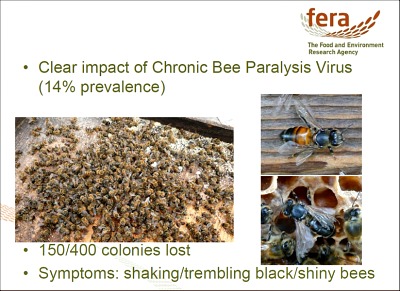National Bee Unit and
UK Nosema Research
Between 2007 and 2008, the UK National Bee Unit and FERA
(Food and Environment Research Agency) carried out a study investigating Honey Bee colony losses in England
and Wales.
Included within this study was the investigation of disease prevalence including the pathogenic fungi, nosema.
A number of studies have highlighted relationships between neonicotinoid pesticides and mortality in bees due to nosema:
- Cédric Alaux et al: Interactions between Nosema microspores and a neonicotinoid
weaken honeybees (Apis mellifera) – Published 2009; Environmental Microbiology.
- Cyril Vidau et al: Exposure to Sublethal Doses of Fipronil and Thiacloprid
Highly Increases Mortality of Honeybees Previously Infected by Nosema ceranae -
Published 2011; PLoS ONE.
- Jeffery S. Pettis et al: Pesticide exposure in honey bees results in increased
levels of the gut pathogen Nosema – Published 2011; Naturwissenschaften.
- Judy Y. Wu et al: Honey bees (Apis mellifera) reared in brood combs containing high levels of pesticide residues exhibit increased susceptibility to Nosema (Microsporidia) infection; Published January 10 2012; Journal of Invertebrate Pathology.
The EFSA Panel on Plant Protection Products - EFSA Journal 2012; 10(5):2668 also commented:
“Indeed, it has been shown that low levels of some pesticides may have synergic actions with diseases such as Nosema. Finding diseases in test colonies, which were healthy before the experiment, and not finding such diseases in control colonies, can imply a synergic effect of pesticides and diseases”.
In April 2011, information was presented to Member of the European Parliament, Julie Girling by Helen Thompson of Fera, and Budge & Brown of the National Bee Unit.
Meeting notes were published, and others were in attendance, including Gavin Lewis of JSC International.
You can find all of the presentations by copying and pasting this web link into a new window:
http://www.juliegirling.com/News/conference-notes-whats-bugging-the-bees
You can download the specific presentation by FERA and the National Bee Unit here (opens a new window).
The presentation refers to a 2 year project to establish disease and pathogen prevalence in England & Wales across 4600 apiaries. Page 13 states:
“Provisional results 2009-2010
• 53% Nosema
negative”

This is an interesting way of presenting the data!
This seems to imply 47% nosema positive, which is a very high percentage!
Imagine
if 47% of the human population were found to be infected with one particular serious disease! The presentation then goes on
to say:
Page
14: “Clear impact of Chronic Bee
Paralysis Virus (14% prevalence)”
Hhmmm………….. that surely implies 86% Chronic Bee Paralysis Virus negative?
So why does the slide not state:
- 86% Chronic Bee Paralysis Virus negative
- Clear impact of Nosema (47% prevalence)
After all, this would seem like a more balanced representation of the data.

The results of the 2 year project were published, and indicate that 45% of the colonies had nosema – 8% of which had 2 strains.
The final report by FERA and the National Bee Unit provides no specific picture as to how many of the colonies actually died from nosema. It doesn’t specifically tell us whether those colonies had been exposed at some point to neonicotinoids.
They also tell us there is no evidence of CCD in the UK (although in any event, definitions vary), but that winter losses 2007 - 2008 were 30%.
Nosema Leaflet
The National Bee Unit had also published a leaflet stating:
“Leading US researchers found N. apis to be more highly associated with CCD (Colony Collapse Disorder) than N. ceranae may well be a key player in CCD.
However, it is likely to be acting in concert with other pathogens or conditions. In Europe the situation is different.
Abnormal colony losses reported in Europe have been attributed to the presence of N. ceranae. N. ceranae was the reported cause of 20,000 colony losses in the Salamanca region of Spain in November 2004……. It is important to note that the pathological data from Spanish apiaries are not consistent with a fast-acting, short-duration syndrome.
More usually, signs of gradual depopulation, low honey production and higher autumn/winter losses are more likely indicators of the presence of this parasite N.ceranae.”
Inspite of this, and the independent studies on nosema and
neonicotinoids such as those listed above, there are no recommendations
that it might be worth monitoring and assessing losses due to Nosema,
and whether or not neonicotinoids make honey bees more susceptible to
death from nosema.
What Else About The National Bee Unit?
It is possible FERA and the National Bee Unit have not been or would not be able to detect neonicotinoids in their samples, which I find equally disconcerting.
Certainly, Pettis et al note, regarding subsequent undetectability of neonicotinoid pesticides:
“The finding that individual bees with undetectable levels of the target pesticide, after being reared in a sub-lethal pesticide environment within the colony, had higher Nosema is significant”.
In addition, whether or not the UK National Bee Unit is likely to have accurately pin-pointed the date of arrival of nosema in the UK, is perhaps a debatable point:
“When originally discovered in Europe in 2005, it was assumed that N. ceranae was a recent arrival (Higes et al., 2006).
Sampling of historical material has demonstrated
that it was present in European mellifera from 1998 (Klee et al., 2007) and
perhaps from the mid-1990s in the USA (Chen et al., 2008)” – from
“Does infection by Nosema ceranae cause
“Colony Collapse Disorder” in honey bees (Apis mellifera)?” - Robert J. Paxton et al, Journal of
Apicultural Research 49(1): 80-84 (2010) © IBRA 2009 DOI 10.3896/IBRA.1.49.1.11
–Downloadable here:
http://www.ibra.org.uk/articles/Nosema-ceranae-and-CCD
I think the prevalence of
nosema and suggested link between it and neonicotinoids, is a cause for
concern, and should be taken seriously by the government.
Questions also need to be raised about the impact on other non-target species - which may become exposed to their own fungal diseases too.
If you found this page helpful or interesting, I'd really be grateful if you would share it with others - if not this page, perhaps another, such as Gardening For Bees.
Thank you so much :) .
Go from National Bee Unit and UK Nosema Research to Home Page